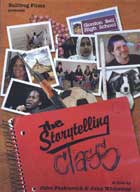
The Storytelling Class 2009
Distributed by Bullfrog Films, PO Box 149, Oley, PA 19547; 800-543-FROG (3764)
Produced by Bullfrog Films
Directed by John Paskievich and John Whiteway
DVD, color, 59 min.
Jr. High - General Adult
Urban Studies, Sociology, Multicultural Studies, Education
Date Entered: 08/26/2011
Reviewed by Caron Knauer, La Guardia Community College, Long Island City, New York“So for me just waking up is enough for me to be happy,” reads Ishamel Beah from his book A Long Way Gone: Memoirs of a Boy Soldier in the opening of this winning documentary about a year in the life of Winnipeg’s inner city, culturally diverse Gordon Bell High School. He goes on to encourage and inspire the audience of students and educators to tell their stories; to not be ashamed of their experiences; that their stories can transform their lives in very positive ways.
Gordon Bell High is comprised of rich and poor Canadians, aboriginals, Afghans, Arabs, Africans, refugees from war-torn countries, immigrants, and a recent influx of Burmese students. Much of the film portrays students talking (we don’t see the interviewer) about their ethnicities and races and how stratified and segregated the school is. One black girl says she stopped talking to people after being made fun of because she has white and Asian friends. Marc Kuly, a teacher, sets out to bring students together by teaching Beah’s memoir about the suffering he endured as a child soldier in Sierra Leone’s civil war. The experience, Kuly says, “was like wildfire spreading through the school. Kids loved it.” Beah’s book “opened a bridge for kids who want to know each other but don’t know how.” One student says all of her problems don’t seem so bad compared to Beah’s; another says he had never enjoyed or even finished a required book before, but he loved Beah’s book.
The film tells the story of this afterschool book project. To begin, students tell each other the story of their names, as Kuly says, the “first part of their stories.” This is followed by a bowing ritual for students to look closely at each other. Giggling ensues—a good sign. Students are encouraged to listen with their hearts, not just their heads. Stories of discrimination and identity are encouraged. Students are asked what they wish for, and Kuly explains the universality of wishing to be part of a better world. Students sit in a circle and articulate their desires. One student says he wishes his father was more devoted to him; another wishes that she was “a healthy kid;” one girl wishes she could feel beautiful—she’s always felt ugly and like a loser. Several students are crying at this point, and Kuly, listening with his heart, reassures them and encourages them to believe in themselves and their dreams.
The students’ stories, mostly about their families, are sometimes horrific and often profound —an Afghan girl witnesses her father being killed; another student talks about having to identify body parts of family members. Beah remains the refrain of the film: he signs books and chats with students; he talks about “the miracle of human interaction”; how he let go of his fears by writing about the difficulties he encountered and the nightmares he still has about his experiences; and ultimately, the comfort he found in telling and sharing his story.
Awards